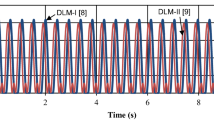Abstract
One of the contemporary architecture trends is the design of structural elements that cover longer clearances to provide flexibility in the architecture of buildings. The technological and constructive evolutions in civil engineering assure the feasibility of such trends due to the use of structural elements with increased slenderness and reduced weight, such as steel structures that utilize dry slabs. However, structures of this type present greater susceptibility to the vibrations related to human activities. Hence, this study aims to evaluate, from the human comfort point of view, the dynamic behavior of an existing steel floor system with composite structural panels, subjected to vibrations due to human walking. To obtain the dynamic responses, the present study employs: (1) simplified procedures of the AISC and SCI design guidelines and (2) modal and transient analyses performed to a numerical model developed using the ANSYS software. The dynamic responses were compared with human comfort criteria prescribed by design guides, ISO 10137:2007 and the Brazilian standards. The influence of the value taken for structural damping and effect of more than one walking individual simultaneously on the structure may be evaluated through numerical results. It was concluded that the simplified procedures underestimate the dynamic responses of the floor system under study.












Similar content being viewed by others
References
ABNT NBR 6118. (2013). Design of concrete structures—Proceeding. Rio de Janeiro: Associação Brasileira de Normas Técnicas (Brazilian Association of Technical Standards) (in Portuguese).
ABNT NBR 8800. (2008). Design of steel and composite steel and concrete structures for buildings. Rio de Janeiro: Associação Brasileira de Normas Técnicas (Brazilian Association of Technical Standards) (in Portuguese).
Ansys® Academic Research Mechanical, Release 17.0
Bachmann, H., & Ammann, W. (1987). Vibrations in structures induced by man and machines. Zurich: International Association for Bridges and Structural Engineering.
Behnia, A., Hong, A. K. B., Shabazi, M. M., et al. (2012). Finite element analysis of high modal dynamic responses of a composite floor subjected to human motion under passive live load. Latin American Journal of Solids and Structures,10, 601–630.
Brownjohn, J. M. W. (1997). Vibration characteristics of a suspension footbridge. Journal of Sound and Vibrations,202(1), 29–46.
Caetano, E., Cunha, Á., Magalhães, F., & Moutinho, C. (2010). Studies for controlling human-induced vibration of the Pedro e Inês footbridge, Portugal. Part 1: Assessment of dynamic behaviour. Engineering Structures,32, 1069–1081.
Campello, E. F. (2013). Mechanical behaviour of reinforced mortar by synthetic and metallic fibers. Ph.D. thesis. Brazil: Federal University Fluminense (in Portuguese).
Costa-Neves, L. F., Silva, J. G. S., Lima, L. R. O., & Jordão, S. (2014). Multi-storey, multi-bay buildings with composite steel-deck floors under human-induced loads: The human comfort issue. Computers and Structures,136, 34–36.
Ebrahimpour, A., & Sack, R. L. (2005). A review of vibration serviceability criteria for floor structures. Computers and Structures,83, 2488–2494.
Gomes, A. V. S., Ribeiro, P. I. S., & Calenzani, A. F. G. (2019). Vibration analysis of a steel floor system with dry floors: A numerical-experimental study. In Proceedings of the XL Ibero-Latin-American congress on computational methods in engineering, Natal/RN, Brazil, November 11–14, 2019.
ISO 10137. (2007). Bases for design of structures—Serviceability of buildings and walkways against vibrations. ISO (International Organization for Standardization).
ISO 2631-2. (2003). Evaluation of human exposure to whole-body vibration—Part 2: Vibrations in buildings (1 to 80 Hz). International Organization for Standardization.
Lai, E., Gentile, C., & Mulas, M. G. (2017). Experimental and numerical serviceability assessment of a steel suspension footbridge. Journal of Constructional Steel Research,132, 16–28.
Louisiana Pacific Corporation. (2012). Technical catalogue. LP Mezanino Cimentício. Paraná: Curitiba. www.lpbrasil.com.br/produtos/lp-mezanino-cimenticio/. Accessed 01 November 2018.
Mello, A. V. A., Silva, J. G. S., Vellasco, P. C. G. S., Andrade, S. A. L., & Lima, L. R. O. (2008). Dynamic analysis of composite systems made of concrete slabs and steel beams. Journal of Constructional Steel Research,64(10), 1142–1151.
Middleton, C. J., & Brownjohn, J. M. W. (2010). Response of high frequency floors: A literature review. Engineering Structures,32, 337–352.
Morrissey, G. C., Dinehart, D. W., & Dunn, W. G. (2009). Wood I-joists with excessive web openings: An experimental and analytical investigation. Journal Structural Engineering,135, 655–665.
Murray, T. M., Allen, D. E., Ungar, E. E., & Davis, D. B. (2016). Vibrations of steel-framed structural systems due to human activity. Steel design guide series 11. American Institute of Steel Construction.
Nikoo, M., Hadzima-Nyarko, M., Nyarko, E. K., & Nikoo, M. (2018). Determining the natural frequency of cantilever beams using ANN and heuristic search. Applied Artificial Intelligence,32(3), 309–334.
Parnell, R., Davis, B. W., & Xu, L. (2010). Vibration performance of lightweight cold formed steel floors. Journal of Structural Engineering,136, 645–653.
Silva, S. S., & Thambiratnam, D. P. (2009). Dynamic characteristics of steel-deck composite floors under human-induced loads. Computers and Structures,87, 1067–1076.
Silva, J. G. S., Vellasco, P. C. G. S., Andrade, S. A. L., Lima, L. R. O., & Figueiredo, F. P. (2007). Vibration analysis of footbridges due to vertical human loads. Computer Structures,85(21–22), 1693–1703.
Smith, A. L., Hicks, S. J., & Devine, P. J. (2009). Design of floors for vibration: A new approach. SCI P354, The Steel Construction Institute, Silwood Park, Ascot, Berkshire, England.
Živanović, S., Pavic, A., & Reynolds, P. (2006). Modal testing and FE model tuning of a lively footbridge structure. Engineering Structures,28, 857–868.
Acknowledgements
The authors would like to acknowledge the support provided by the Brazilian public agencies CAPES, CNPq and FAPES.
Author information
Authors and Affiliations
Corresponding author
Additional information
Publisher's Note
Springer Nature remains neutral with regard to jurisdictional claims in published maps and institutional affiliations.
Rights and permissions
About this article
Cite this article
Ribeiro, P.I.S., Gomes, A.V.S. & Calenzani, A.F.G. Dynamic Analysis of a Steel Floor System with Dry Slabs Subjected to Vibrations Due to Human Walking. Int J Steel Struct 20, 969–984 (2020). https://doi.org/10.1007/s13296-020-00335-3
Received:
Accepted:
Published:
Issue Date:
DOI: https://doi.org/10.1007/s13296-020-00335-3




